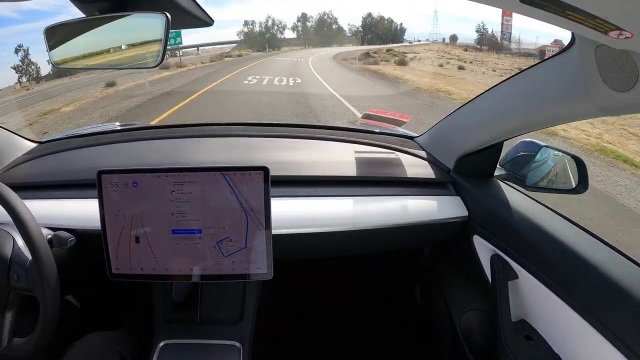The owner of the Tesla Model 3 car conducted an interesting experiment — drove the route from San Francisco to Los Angeles and back on autopilot. In the cities, the car moved under the control of the beta version of the Full Self-Driving (FSD) function, and on the highway it worked in Autopilot (AP) mode. For more than 12 hours of driving, the driver took control for only five minutes.
Videos with an accelerated video sequence of two more than six-hour trips are published on the YouTube channel Whole Mars Catalog. Their author is the lucky owner of Model 3, which received a beta version of FSD with a recent update. This means that now the car is able to drive independently not only on the highway, but also in the city. The driver is only required to set the route and do not remove his hands from the steering wheel. Of course, all responsibility for any shortcomings during movement in this mode lies with the person: he is obliged to constantly monitor what is happening.
During the experiment conducted by the Whole Mars Catalog, the driver interfered with the control only a few times: to drive three times to the charging stations and once to avoid garbage on the road. Although in the latter case it was reinsurance. As the caption to the first video says, its author decided not to wait for the car to go around the obstacle-the experiment was fraught with damage to the car. Incomprehensible garbage was lying around a concrete bump, and hitting it at a speed of about 80 miles per hour (128 kilometers per hour) it could have ended badly. This maneuver is visible at the 12: 51 timestamp of the first video.
© Whole Mars Catalog, YouTube
Both videos demonstrate how Tesla's electronics switch between modes and how well the car drives itself. In the city, an information display shows the world around us through the "eyes" of the FSD function. It looks even funny — as if the child in real time schematically sketches the road, other road users and pedestrians on the sheet. As soon as the Model 3 moves onto the highway, the "autopilot" interface, which has long been familiar to Tesla owners, appears. It shows the lane in which the electric car is traveling, as well as the adjacent rows of the road with the cars located there.
In Autopilot mode, when the car is controlled by electronics, the steering wheel icon lights up blue in the upper-left corner of the screen next to the speedometer. On this basis, you can easily see that most of the video is not fake. Of course, because of the fast installation, not all the moments of the journey were included in the video, which is accelerated by 24 times. However, the author promised to find a way to lay out the entire video series for fans to look for a trick. Or those who want to" under the microscope " to assess how well the functions of the Tesla autopilot do their job.
© Whole Mars Catalog, YouTube
The author of the videos himself notes that driving a Tesla with both Full Self-Drivingand Autopilot functions is not always ideal. The car can sometimes not be the most logical way to change lanes or perform overtaking. Traffic rules are not violated, and there are no direct security threats, but drivers around this behavior can cause some confusion. And unpredictable movement in the flow-in itself creates a security threat. Therefore, FSD has been in beta test status for two months and it is still unclear when it will be released in a full-fledged format for everyone.
Since the Whole Mars Catalog has only the Model 3 in a not very "hardy" configuration, its battery was not enough for all 600 kilometers of one-way road. Therefore, during the trip to Los Angeles, the charging stations had to be visited twice (at the time of launch, the battery was partially charged). But the return trip to San Francisco started on a full battery, so there was only one stop. The author urged to repeat his experiment to those who have a Model S with a mileage on a single charge of more than 400 miles.

